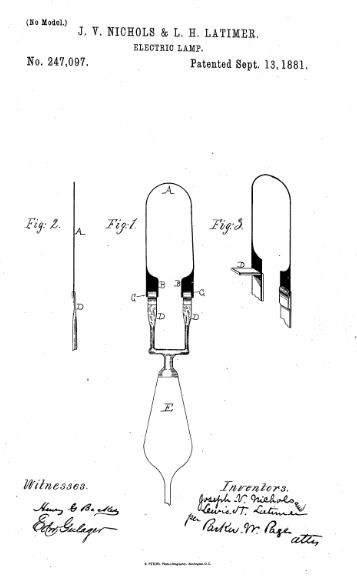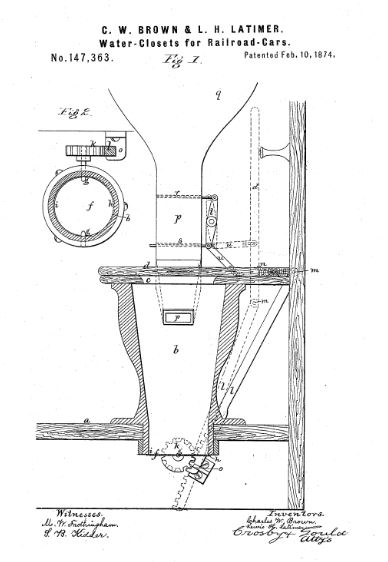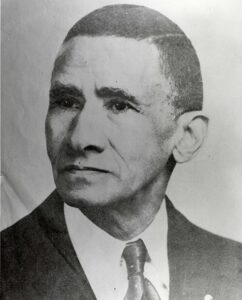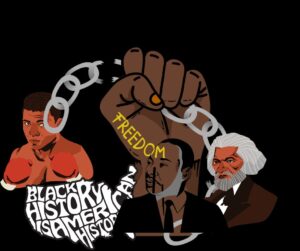Once upon a time in Black Entrepreneur History was an African American man named Lewis Howard Latimer, son of formerly enslaved parents, who went on to become a serial inventor of the Electric Lamp, Telephone, Improved Railway Toilet and more, along with becoming an educator, writer, author and instrumentalist.
Lewis Latimer was born September 4, 1848 in Chelsea, Massachusetts, and he was born the son of a Black woman named Rebecca who escaped her enslavement, along with his enslaved father named George, from the southern state of Virginia. While Lewis was still in his mother’s womb, they escaped, along with their children, therefore, Lewis was their first child born free at birth. He was the youngest.
In Boston, as a young child, he would help his father with work. His father had become a self employed barber and in the evenings did handy work by hanging wallpaper for clients. However, things took a turn when Lewis Latimer was ten years old. His parents had to separate because a law was passed that if a formerly enslaved couldn’t prove he was free, then they couldn’t legally be free. His father didn’t have papers proving his freedom, so he made the heartbreaking decision to flee for the protection of his family. His father ended up forced into abandoning the family.
Lewis needed to help support the family as best he could as a young teenager after this so he, at sixteen years old, became a Landsman after enlisting in the Naval Service. He was a Landsman on the USS Massasoit ship, and was honorably discharged in 1865 at the age of 17. Before he was discharged however, he learned to use various tools of measurement and drawing proficiently and was earning a high weekly salary.
Afterward leaving the Navy, he began to sell copies of the abolitionist newspaper founded by abolitionist William Lloyd Garrison called the Liberator. He stood on the street and sold The Liberator to earn money and this also made him a supporter of the abolitionist movement to end slavery in the United States of America.
Lewis Latimer’s Invention Career
While a young abolitionist, he also started working at Crosby and Gould, a patent law firm. It was here that he met Alexander Graham Bell who was a teacher of the deaf at a school nearby and was the alleged sole inventor of a telephone ringer to help his wife with her hearing. She was deaf and couldn’t talk. It was Latimer, who was only in his early to mid 20s in age, that drew all the patent drawings for Bell as well as fill out the patent application forms. Only with Lewis Howard Latimer’s help and expertise did Alexander Graham Bell win the patent for the telephone. Unfortunately, Latimer’s name is left off the patent for the telephone despite he was the one who actually invented the telephone as he not only did the patent paperwork but also the patent drawings to prove how it is suppose to work and function, to which Alexander Graham Bell could not and did not do. Even if some would say they worked on it together, there should be two names on the patent, not only Bell.

All of this experience gave him knowledge of the patenting and invention process. From there he was hired by Hiram S. Maxim, inventor of the first automatic machine gun, and this is where he became popular among electrical inventions and inventors. It was during this time that he invented the first electric light with a carbon filament called the Electric Lamp, patented on September 13, 1881.(No. 247.097)
His invention related to the way in which the “light is produced by the incandescence of a continuous strip of carbon secured by metallic wires in a transparent receiver” along with “the method of mounting the carbons or connecting them to the wires”.
From there, Maxim and Charles Weston developed factories in order to manufacture Latimer’s invention, later becoming Westinghouse Company, founded by Charles Weston.
Latimer knew the possibilities of his lamps which were now on being created in the USA, so he set out to learn French which was spoken in Canada, a place where many of his lamps were being sold. He needed not only the instructions on how to use his lamps to be written in English but French as well to accommodate everyone.
He traveled to various places demonstrating and teaching how to use the lamp in the America and Europe before joining Thomas Edison’s company in 1884 to work in the engineering and legal departments in New York City. Being a Black man, he faced many challenges while working but he was determined despite it all until leaving in 1892 to work with General Electric and worked with them for twenty years[1].
He became the only African American member of the Edison Pioneers which was formed in 1918 for those who worked with Thomas Edison at his companies[2].

Not only did Latimer invent the first Electric Lamp, but he also invented locking racks for hats, coats, umbrellas and more merchandise. (See picture here)
Lewis H. Latimer also invented the first toilet to be installed in trains known as the ” Water Closet for Rail Cars” (photo to left, No. 147,363) on February 10, 1864. Latimer improved the previous Water Closet by giving the toilet a bottom instead of allowing the waste to hit the ground as the previous water closet toilets, splashing waste everywhere on the ground and tracks, even back upon the train.
With this toilet, it was made with a lid that once opened, the pivoting bottom pan would come up and could pivot 180 degrees when the lid closed. Therefore, the waste would be caught in the bottom pan and when the toilet lid closed, the bottom pan would pivot away. This made for a much cleaner way to use the bathroom.
Latimer also invented the “Apparatus for Cooling and Disinfecting” on January 18, 1886. (See invention here) Latimer’s invention presented a large evaporating surface in order to cool the air that passes over it or charge it with chemical agents to destroy odors and germs that cause disease. He accomplished this by stretching a textile fabric webbing between a reservoir and drip-pan to keep webbing saturated and supply the waste by evaporation, like a filtration system.
Lewis Howard Latimer TextbBooks, Literature, Art & Music
All of this led him to writing his first textbook on electric lighting in 1890 titled Incandescent Electric Lighting, a Practical Description of the Edison System. That wasn’t his only book however. He was also a poet, and wrote a book of poetry titled Poems of Love and Life as well as short stories and a “caustic critic”[3].
He proved he was more than an inventor with his creative mind when he proved to be an instrumentalist, playing the flute and violin along with having a hand with painting beautiful portraits as an artist as well as being a scriptwriter having written a number of plays. He also written for African American journals while teaching the English language to immigrants at the Henry Street Settlement in New York.
As far as more of his abolitionist work besides handling The Liberator papers when he was younger in his teens, Lewis Howard Latimer corresponded with Booker T. Washington and Frederick Douglass often for the cause of African American independence. He also helped establish a Unitarian church in New York[4].
Marriage
He married a woman by the name of Mary Wilson (Latimer) when he was 25 years of age in Fall River, Massachusetts, and they had two children.
Death
Latimer died on December 11, 1928 in Flushing, New York and was buried in Oak Grove Cemetery in Fall River, Massachusetts[5].
Sources
The Courier (Waterloo, Iowa)· Sun, Feb 26, 1995 · Page 47
[1,4]The Courier-Journal (Louisville, Kentucky) 08 Feb 2006, Wed Page B2
[2]The Courier-Journal (Louisville, Kentucky) 08 Feb 2006, Wed Page B1
[3]Buffalo Evening News (Buffalo, New York) 23 Jan 1892, Sat Page 10
[5]Ancestry.com. U.S., Find A Grave Index, 1600s-Current [database on-line]. Provo, UT, USA: Ancestry.com Operations, Inc., 2012.
Photo of Latimer: By Unknown author – http://www.lrc.rpi.edu/resources/news/pressReleases/img/Lewis.jpg, Public Domain, https://commons.wikimedia.org/w/index.php?curid=2032528





More Related Stories
Isaac Scott Hathaway – Founder of Isaac Hathaway Art Company & Designer of First African American Coin
A Black American Man Invented the First Gravity Car in 1874, But Questionably Died Right Before It Displayed
William C. Linton – Founder of The Chicago Whip Newspaper